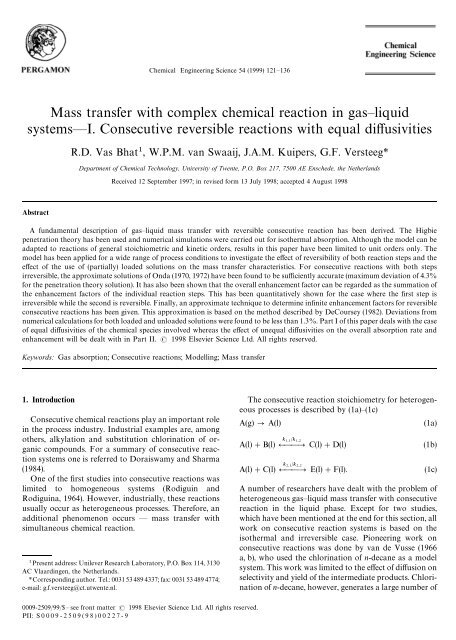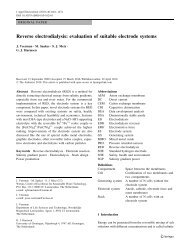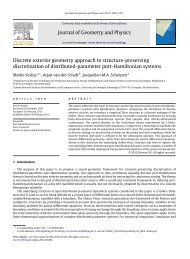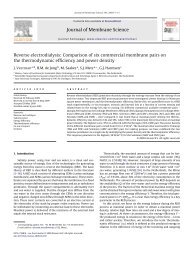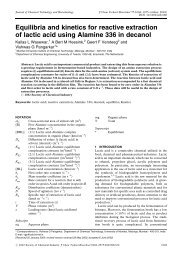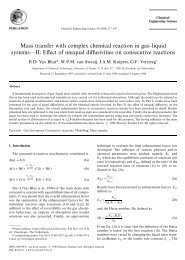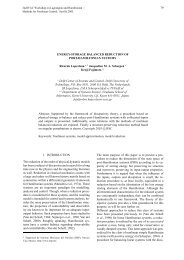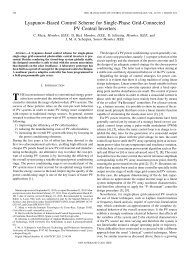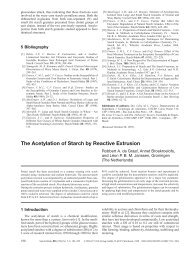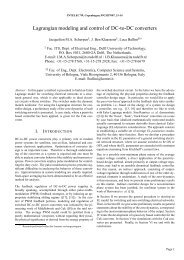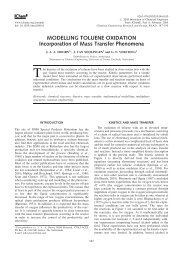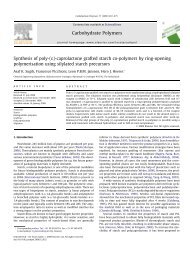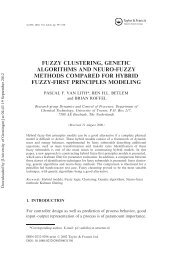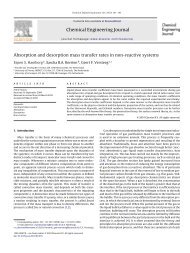Mass transfer with complex chemical reaction in gas—liquid ... - ITM
Mass transfer with complex chemical reaction in gas—liquid ... - ITM
Mass transfer with complex chemical reaction in gas—liquid ... - ITM
Create successful ePaper yourself
Turn your PDF publications into a flip-book with our unique Google optimized e-Paper software.
Chemical Eng<strong>in</strong>eer<strong>in</strong>g Science 54 (1999) 121—136<strong>Mass</strong> <strong>transfer</strong> <strong>with</strong> <strong>complex</strong> <strong>chemical</strong> <strong>reaction</strong> <strong>in</strong> <strong>gas—liquid</strong>systems—I. Consecutive reversible <strong>reaction</strong>s <strong>with</strong> equal diffusivitiesR.D. Vas Bhat, W.P.M. van Swaaij, J.A.M. Kuipers, G.F. Versteeg*Department of Chemical Technology, University of Twente, P.O. Box 217, 7500 AE Enschede, the NetherlandsReceived 12 September 1997; <strong>in</strong> revised form 13 July 1998; accepted 4 August 1998AbstractA fundamental description of <strong>gas—liquid</strong> mass <strong>transfer</strong> <strong>with</strong> reversible consecutive <strong>reaction</strong> has been derived. The Higbiepenetration theory has been used and numerical simulations were carried out for isothermal absorption. Although the model can beadapted to <strong>reaction</strong>s of general stoichiometric and k<strong>in</strong>etic orders, results <strong>in</strong> this paper have been limited to unit orders only. Themodel has been applied for a wide range of process conditions to <strong>in</strong>vestigate the effect of reversibility of both <strong>reaction</strong> steps and theeffect of the use of (partially) loaded solutions on the mass <strong>transfer</strong> characteristics. For consecutive <strong>reaction</strong>s <strong>with</strong> both stepsirreversible, the approximate solutions of Onda (1970, 1972) have been found to be sufficiently accurate (maximum deviation of 4.3%for the penetration theory solution). It has also been shown that the overall enhancement factor can be regarded as the summation ofthe enhancement factors of the <strong>in</strong>dividual <strong>reaction</strong> steps. This has been quantitatively shown for the case where the first step isirreversible while the second is reversible. F<strong>in</strong>ally, an approximate technique to determ<strong>in</strong>e <strong>in</strong>f<strong>in</strong>ite enhancement factors for reversibleconsecutive <strong>reaction</strong>s has been given. This approximation is based on the method described by DeCoursey (1982). Deviations fromnumerical calculations for both loaded and unloaded solutions were found to be less than 1.3%. Part I of this paper deals <strong>with</strong> the caseof equal diffusivities of the <strong>chemical</strong> species <strong>in</strong>volved whereas the effect of unequal diffusivities on the overall absorption rate andenhancement will be dealt <strong>with</strong> <strong>in</strong> Part II. 1998 Elsevier Science Ltd. All rights reserved.Keywords: Gas absorption; Consecutive <strong>reaction</strong>s; Modell<strong>in</strong>g; <strong>Mass</strong> <strong>transfer</strong>1. IntroductionConsecutive <strong>chemical</strong> <strong>reaction</strong>s play an important role<strong>in</strong> the process <strong>in</strong>dustry. Industrial examples are, amongothers, alkylation and substitution chlor<strong>in</strong>ation of organiccompounds. For a summary of consecutive <strong>reaction</strong>systems one is referred to Doraiswamy and Sharma(1984).One of the first studies <strong>in</strong>to consecutive <strong>reaction</strong>s waslimited to homogeneous systems (Rodigu<strong>in</strong> andRodigu<strong>in</strong>a, 1964). However, <strong>in</strong>dustrially, these <strong>reaction</strong>susually occur as heterogeneous processes. Therefore, anadditional phenomenon occurs — mass <strong>transfer</strong> <strong>with</strong>simultaneous <strong>chemical</strong> <strong>reaction</strong>.Present address: Unilever Research Laboratory, P.O. Box 114, 3130AC Vlaard<strong>in</strong>gen, the Netherlands.*Correspond<strong>in</strong>g author. Tel.: 0031 53 489 4337; fax: 0031 53 489 4774;e-mail: g.f.versteeg@ct.utwente.nl.The consecutive <strong>reaction</strong> stoichiometry for heterogeneousprocesses is described by (1a)—(1c)A(g) P A(l)(1a)A(l)#B(l) Q&&P C(l)#D(l)A(l)#C(l) Q&&P E(l)#F(l).(1b)(1c)A number of researchers have dealt <strong>with</strong> the problem ofheterogeneous <strong>gas—liquid</strong> mass <strong>transfer</strong> <strong>with</strong> consecutive<strong>reaction</strong> <strong>in</strong> the liquid phase. Except for two studies,which have been mentioned at the end for this section, allwork on consecutive <strong>reaction</strong> systems is based on theisothermal and irreversible case. Pioneer<strong>in</strong>g work onconsecutive <strong>reaction</strong>s was done by van de Vusse (1966a, b), who used the chlor<strong>in</strong>ation of n-decane as a modelsystem. This work was limited to the effect of diffusion onselectivity and yield of the <strong>in</strong>termediate products. Chlor<strong>in</strong>ationof n-decane, however, generates a large number of0009-2509/99/$— see front matter 1998 Elsevier Science Ltd. All rights reserved.PII: S 0 0 0 9 - 2 5 0 9 ( 9 8 ) 0 0 2 2 7 - 9
122 R.D. Vas Bhat et al./Chemical Eng<strong>in</strong>eer<strong>in</strong>g Science 54 (1999) 121—136side products, thereby complicat<strong>in</strong>g the fundamentalanalysis of such a system. Hence, it was found necessaryto seek model systems <strong>with</strong> a limited number of <strong>reaction</strong>paths. With this, the mass <strong>transfer</strong> phenomena could be<strong>in</strong>vestigated more thoroughly. Inoue and Kobayashi(1968) suggested the use of chlor<strong>in</strong>ation of p-cresol dissolved<strong>in</strong> carbon tetrachloride s<strong>in</strong>ce this system consistsof only two <strong>reaction</strong>s. They also measured rate constantsfor both the <strong>reaction</strong> steps <strong>in</strong>volved. This experimentalsystem was also used by Hashimoto et al. (1968) andTeramoto et al. (1969, 1970), who presented an approximatemethod for estimat<strong>in</strong>g the yield of the <strong>in</strong>termediateproduct at a given <strong>reaction</strong> time. This was validatedexperimentally <strong>with</strong> chlor<strong>in</strong>ation experiments <strong>in</strong> a stirredcell. Further work on the effect of mass <strong>transfer</strong> on theselectivity of the <strong>in</strong>termediate product was done by Pangarkarand Sharma (1974). They derived approximatesolutions for selectivity of the <strong>in</strong>termediate, based on thefilm theory, which were then validated experimentally<strong>with</strong> the chlor<strong>in</strong>ation of p-cresol. Special emphasis wasplaced on the case where depletion of the liquid reactivespecies occurs and for <strong>in</strong>stantaneous consecutive <strong>reaction</strong>.Darde et al. (1983, 1984a, b) <strong>in</strong>corporated the consecutive<strong>reaction</strong> scheme us<strong>in</strong>g the film theory <strong>in</strong>toa model for an ideal CSTR and the results were found toagree <strong>with</strong> experiments on chlor<strong>in</strong>ation of p-cresol carriedout <strong>in</strong> a bubble column (modelled as a cascade ofCSTRs).Some work that had appeared <strong>in</strong> literature was focusedon approximations to determ<strong>in</strong>e selectivity and yield ofthe <strong>in</strong>termediate <strong>with</strong>out actual experimental validation.Kubota and Lee (1973) gave an analytical approximationfor selectivity based on the method of van Krevelen andHoftijzer. Kastánek and Fialová (1982) elaborated thismethod by propos<strong>in</strong>g simple empirical criteria for thesafe application of the approximate solutions and comparedthe analytical approximations <strong>with</strong> numericalsolutions of the film theory. Approximate solutions forthe enhancement factor have been provided by Onda etal. (1970, 1972), who derived semi-analytical solutions forthe film and penetration theory for the case where both<strong>reaction</strong> steps may be considered irreversible. A moredetailed description of the absorption rate for the casepresented by Onda (1970, 1972) was provided byHuang et al. (1980), who presented quantitativevalues of enhancement factors over a range of Hattanumbers us<strong>in</strong>g both film and penetration theory solutions.They observed that the difference <strong>in</strong> the enhancementfactors obta<strong>in</strong>ed from the two theories was alwaysless than 2%.It is only the work of Kuo and Huang (1973) thatstudies the effect of reversibility on consecutive <strong>reaction</strong>s.However, this study was conducted for a simplified <strong>reaction</strong>stoichiometry (see Section 4.4.5). The authorsshowed that the effect of reversibility was to reduce theabsorption rate and, thereby, the enhancement as comparedto the irreversible <strong>reaction</strong> scheme. In the case ofnon-isothermal absorption, an analysis of exothermicirreversible consecutive <strong>reaction</strong> was made by Bhattacharyaet al. (1988). The authors provided approximateanalytical solutions for the <strong>in</strong>terfacial temperature riseand the enhancement factor as a function of the Hattanumber.The limitation of irreversibility of consecutive <strong>reaction</strong>shas been overcome <strong>in</strong> the present study. However,isothermal absorption has still been assumed. The Higbiepenetration theory has been used for this study. Further,an analysis of gas absorption <strong>in</strong>to loaded solutions hasbeen presented. The results obta<strong>in</strong>ed have then beencompared to available literature after mak<strong>in</strong>g necessarysimplifications. For an overview of the exist<strong>in</strong>g literatureon <strong>reaction</strong>s <strong>with</strong> simplified stoichiometries, the reader isreferred to the review by van Swaaij and Versteeg (1992)on the subject. Part I of the study is limited to the case ofequal diffusivities of all <strong>chemical</strong> species <strong>in</strong>volved whereasPart II focuses on the effect of unequal diffusivities onthe absorption rate and its correspond<strong>in</strong>g effect on theoverall enhancement factor.2. Theory2.1. Species conservation equationsThe <strong>reaction</strong> stoichiometry under consideration isgiven by <strong>reaction</strong>s (1a)—(1c). The numerical description,however, considers general stoichiometric and k<strong>in</strong>eticorders of the different <strong>chemical</strong> species.Based on the penetration theory, the unsteady-statespecies conservation equations may be written asAt "D A x !R !R Bt "D B x !R Ct "D C x #R !R Dt "D D x #R Et "D E x #R Ft "D F x #R .(2a)(2b)(2c)(2d)(2e)(2f)It is assumed that the k<strong>in</strong>etic expressions can be describedby simple power-law expressions (3a) and (3b), as
R.D. Vas Bhat et al./Chemical Eng<strong>in</strong>eer<strong>in</strong>g Science 54 (1999) 121—136 123they are usually accurate enough for estimation of local<strong>reaction</strong> ratesR "k AB!k CDR "k AC!k EF.(3a)(3b)The species conservation equations have been solved<strong>with</strong> the follow<strong>in</strong>g <strong>in</strong>itial (4a) and boundary conditions(4b)—(4d):<strong>in</strong>itial:t"0, x*0NA"A , B"B , C"C ,D"D , E"E , F"F (4a)boundary:t'0, x"0Nk (A !A )"!D Ax (4b)t'0; x"0N B "x C "x D "x E x "x F "0t'0, xPRNA"A , B"B , C"C , D"D , E"E , F"F .(4c)(4d)Under conditions where the liquid is already loaded <strong>with</strong>the gas-phase component, the bulk equilibrium of all<strong>chemical</strong> species needs to be considered. A load<strong>in</strong>g factor,α is def<strong>in</strong>ed asA "αB (5a) where A and B are the total bulk concentrations of A and B <strong>in</strong> all forms. These are def<strong>in</strong>ed asA "A #D #E B "B #D . (5b)(5c)Here, B is the <strong>in</strong>itial amount of B added to the solutionbefore equilibrium. The equilibrium concentrations of allthe species at a given solute load<strong>in</strong>g is determ<strong>in</strong>ed bysolv<strong>in</strong>g Eqs. (5a) and (5b) along <strong>with</strong> the equilibriumdef<strong>in</strong>itions and mass balances.K A B !C D "0K A C !E F "0D !C !E "0E !F "0.(5d)(5e)(5f)(5g)Table 1Program <strong>in</strong>put parametersVariable Value UnitsA 10 mol mB 1000*, 40 mol mk 10—10 msk 0.25—2.610 m mol sK 0.01—100 —K 0.01—100 —K 10—10 —α 10—0.999 —D 10 m s*Initial concentration of B when both <strong>reaction</strong>s are irreversible.Here, K and K are def<strong>in</strong>ed as the equilibrium constantsfor <strong>reaction</strong>s (1b) and (1c), respectively. The equilibrium<strong>reaction</strong>s (5d)—(5g) are sufficient to describe the <strong>reaction</strong>stoichiometry under consideration. However, for applicationsto practical systems, it is usually necessary toconsider additional equilibria. For example, aqueousequilibria and/or electroneutrality would have to be consideredif electrolytic systems are studied.2.2. Numerical modelThe set of partial differential equations (2a)—(2f) subjectto <strong>in</strong>itial and boundary conditions (4a)—(4d) wassolved us<strong>in</strong>g a technique similar to that described byVersteeg et al. (1989). The numerical code has been implemented<strong>in</strong> PASCAL.The set of equilibrium Eqs. (5a)—(5g) were solved separatelyus<strong>in</strong>g a Newton—Raphson algorithm for a givenvalue of B , K and K to obta<strong>in</strong> the <strong>in</strong>itial bulk concentrationsof all species at different load<strong>in</strong>g factors, α.The variables used <strong>in</strong> the present simulations are given<strong>in</strong> Table 1.3. ValidationBy vary<strong>in</strong>g the process parameters and/or conditionssuch as stoichiometric and k<strong>in</strong>etic orders, k<strong>in</strong>etic rateconstants and mass <strong>transfer</strong> coefficients, it is possible tosimplify the generalised stoichiometry given by <strong>reaction</strong>s(1a)—(1c) to simpler systems for which analytical andsemi-analytical solutions are available. The enhancementfactors calculated as a function of the correspond<strong>in</strong>gHatta number are compared <strong>with</strong> the results available <strong>in</strong>open literature.The systems used to validate the numerical code andthe correspond<strong>in</strong>g results obta<strong>in</strong>ed are given <strong>in</strong> Table 2.The results obta<strong>in</strong>ed are well <strong>with</strong><strong>in</strong> the <strong>in</strong>herent deviationsto be expected when compar<strong>in</strong>g the numericalresults <strong>with</strong> approximate or semi-analytical solutionsused for the validation. These deviations could be onaccount of the use of the film theory or l<strong>in</strong>earisationbased on the Hikita—Asai or van Krevelen—Hoftijzer approximation.This confirms the accuracy of the numerical
124 R.D. Vas Bhat et al./Chemical Eng<strong>in</strong>eer<strong>in</strong>g Science 54 (1999) 121—136Table 2Reaction stoichiometries considered for the validation of the numerical code together <strong>with</strong> the maximum and average deviations found <strong>in</strong> thenumerical computationsCase K<strong>in</strong>etic Maximum Average Number of Validation literatureexpression deviation (%) deviation (%) po<strong>in</strong>tsFirst-order irreversible k A 0.73 0.11 24 Higbie (1935)Second-order irreversible k AB 3.72 0.94 24 DeCoursey (1974)Yeramian et al. (1970)Second-order reversible k AB!k CD 5.36 1.67 80 DeCoursey and Thr<strong>in</strong>g (1989) Second-order reversible k AB!k CD 5.90 1.0 124 DeCoursey and Thr<strong>in</strong>g (1989) <strong>with</strong> unequal diffusivities D OD Second-order reversible k AB!k CD 6.00 2.1 144 DeCoursey and Thr<strong>in</strong>g (1989) <strong>with</strong> loaded solutions A "αB Deviation def<strong>in</strong>ed as: dev" E !E 100 .E EAverage deviation is def<strong>in</strong>ed as: avgdev" Number of po<strong>in</strong>ts .code used for the mass <strong>transfer</strong> flux calculations <strong>with</strong>consecutive <strong>chemical</strong> <strong>reaction</strong>.4. Consecutive <strong>reaction</strong>s4.1. Both <strong>reaction</strong>s irreversibleThe simplest form of consecutive <strong>reaction</strong>s <strong>with</strong> unitstoichiometric and k<strong>in</strong>etic orders has been studied earlierby Onda and co-workers (1970, 1972). The same systemwas numerically <strong>in</strong>vestigated by Huang et al. (1980).Results obta<strong>in</strong>ed from simulations, carried out <strong>with</strong>the model described <strong>in</strong> this paper, are presented <strong>in</strong> Fig.1(a) as enhancement factor, E , def<strong>in</strong>ed asE "N (6a) k (A !A ) which is the ratio of <strong>chemical</strong> to physical flux underidentical concentration driv<strong>in</strong>g force, over a range ofHatta numbers, Ha, def<strong>in</strong>ed asHa" k B D . (6b)k From Eq. (6b), it is clear that the Hatta number, used <strong>in</strong>this study, is def<strong>in</strong>ed on the basis of the first <strong>reaction</strong> (1b).The Hatta numbers were varied by chang<strong>in</strong>g, either theliquid mass <strong>transfer</strong> coefficient, k , or the k<strong>in</strong>etic rateconstants. The vary<strong>in</strong>g parameter <strong>in</strong> the graph, K ,is def<strong>in</strong>ed as the ratio of the forward rate constantsK " k .(6c) k The follow<strong>in</strong>g po<strong>in</strong>ts need to be noted:(a) The <strong>reaction</strong>s show a characteristic two-step <strong>in</strong>crease<strong>in</strong> the enhancement factor. Each step can be seenas a contribution by the <strong>in</strong>dividual <strong>reaction</strong>s to the totalenhancement. If <strong>reaction</strong> (1c) is slower than <strong>reaction</strong> (1b),then, at lower Ha, the absorption of A is determ<strong>in</strong>ed by<strong>reaction</strong> (1b) only. Consequently, the enhancement factor<strong>in</strong>creases, as is observed for a s<strong>in</strong>gle irreversible <strong>reaction</strong>,to its asymptotic value called the <strong>in</strong>termediate asymptoticenhancement factor (E ). However, at higher Ha, sufficient<strong>in</strong>termediate C is produced <strong>with</strong><strong>in</strong> the penetrationdepth so that <strong>reaction</strong> (1c) can also <strong>in</strong>fluence the absorptionof A. As a result, the enhancement factor further<strong>in</strong>creases from the <strong>in</strong>termediate asymptotic value (E )to its f<strong>in</strong>al value. This value has been called the f<strong>in</strong>al<strong>in</strong>f<strong>in</strong>ite enhancement factor (E ). In addition, the po<strong>in</strong>t atwhich one observes the additional enhancement providedby the second <strong>reaction</strong> has been def<strong>in</strong>ed as the‘kick-<strong>in</strong>’ po<strong>in</strong>t. A typical ‘kick-<strong>in</strong>’ po<strong>in</strong>t for one case (K "10) is shown <strong>in</strong> Fig. 1(a).(b) At extremely high Ha (Ha'10), both <strong>reaction</strong>s(1b) and (1c) are <strong>in</strong>stantaneous <strong>with</strong> respect to mass<strong>transfer</strong>. Under these conditions the overall <strong>reaction</strong>scheme simplifies to:2A(l)#B(l) P D(l)#E(l)#F(l). (7)The <strong>in</strong>f<strong>in</strong>ite enhancement factor E , for the stoichiometrygiven above and equal diffusivities, is def<strong>in</strong>edasE "1# 2B A . (8)It is observed that all <strong>reaction</strong>s, irrespective of K ,f<strong>in</strong>ally converge to the same E .(c) The value of K is <strong>in</strong>dicative of the reactivity ofthe <strong>in</strong>termediate C <strong>with</strong> A. At very low values ofK (typically 10), the <strong>reaction</strong> between A and C isnoticeable only at very high Hatta numbers. For sucha case, a clear <strong>in</strong>termediate asymptotic enhancement
R.D. Vas Bhat et al./Chemical Eng<strong>in</strong>eer<strong>in</strong>g Science 54 (1999) 121—136 125Fig. 1. (a) Effect of K on enhancement factor. Irreversible consecutive <strong>reaction</strong>. Dist<strong>in</strong>ct two-step <strong>in</strong>crease <strong>in</strong> enhancement observed <strong>with</strong> the ‘kick-<strong>in</strong>’po<strong>in</strong>t <strong>in</strong>dicated for K "10. K "(k /k ). (b) Deviation between Onda’s solutions and results from present model. Relative deviation%" (E !E )100E .factor is observed. This <strong>in</strong>termediate value is equal to the<strong>in</strong>f<strong>in</strong>ite enhancement factor for a s<strong>in</strong>gle irreversible <strong>reaction</strong>(1b). For conditions of equal diffusivity, the value ofE for K "10"(1#B /A ). This corresponds tothe value of 101 seen <strong>in</strong> Fig. 1(a). With an <strong>in</strong>crease <strong>in</strong> K ,the ‘kick-<strong>in</strong>’ po<strong>in</strong>t shifts to lower Hatta numbers. A highervalue of K <strong>in</strong>dicates higher <strong>reaction</strong> rates of C <strong>with</strong>A so that <strong>reaction</strong> (1c) can <strong>in</strong>fluence the absorption ofA at <strong>in</strong>creas<strong>in</strong>gly lower Ha. Consequently, this meansthat the f<strong>in</strong>al <strong>in</strong>f<strong>in</strong>ite enhancement factor is also achievedat <strong>in</strong>creas<strong>in</strong>gly lower Hatta numbers. For K '1, <strong>reaction</strong>(1c) is <strong>in</strong>stantaneous over the entire range of Hattanumbers so that any <strong>in</strong>termediate C formed is immediatelyconsumed by <strong>reaction</strong>s (1c). No <strong>in</strong>termediate plateau<strong>in</strong> enhancement is seen and the value of E rises toits f<strong>in</strong>al <strong>in</strong>f<strong>in</strong>ite value directly. The overall <strong>reaction</strong>stoichiometry is then represented by <strong>reaction</strong> (7) result<strong>in</strong>g<strong>in</strong> a value of E as def<strong>in</strong>ed <strong>in</strong> Eq. (8). This corresponds tothe value of 201 as seen <strong>in</strong> Figure 1(a). For <strong>in</strong>termediatevalues of K , the value of E varies <strong>with</strong><strong>in</strong> these twoasymptotes.4.1.1. Comments on Onda et al. (1970, 1972)Onda and co-workers have provided semi-analyticalsolutions for enhancement factor as function of Hattanumber for irreversible consecutive <strong>reaction</strong>. The enhancementfactors have been obta<strong>in</strong>ed by l<strong>in</strong>earis<strong>in</strong>g theset of non-l<strong>in</strong>ear differential species conservation Eqs.(2a)—(2c) us<strong>in</strong>g the Hikita—Asai technique. The result<strong>in</strong>gapproximate solutions can be applied to consecutive
R.D. Vas Bhat et al./Chemical Eng<strong>in</strong>eer<strong>in</strong>g Science 54 (1999) 121—136 127Fig. 2. Effect of K on enhancement factor. Consecutive (irr)—(rev) <strong>reaction</strong>.<strong>with</strong> the presently obta<strong>in</strong>ed numerical results forlow Hatta numbers (Ha(3). A maximum deviation of5.8% was seen for the lowest Hatta number (Ha"1)while for higher Hatta numbers the agreement was muchbetter.4.2. First <strong>reaction</strong> irreversible—second <strong>reaction</strong> reversibleThe results from the simulation for the above case aregiven <strong>in</strong> Fig. 2 for K "10. As may be observed, the<strong>in</strong>itial part of the curve is similar to a second orderirreversible <strong>reaction</strong> and can be described <strong>with</strong> availabletechniques (e.g. DeCoursey, 1974) till the curve reachesthe <strong>in</strong>termediate asymptotic enhancement value. For thecase of equal diffusivities, the value of E correspondsto the quantity (1# B /A ). As Ha <strong>in</strong>creases further, thefirst <strong>reaction</strong> becomes <strong>in</strong>stantaneous <strong>with</strong> respect to mass<strong>transfer</strong> so that, now, further enhancement is essentiallyprovided by the second <strong>reaction</strong>.4.2.1. Effect of K From Fig. 2 it is clear that the value of K <strong>in</strong>fluencesthe f<strong>in</strong>al <strong>in</strong>f<strong>in</strong>ite enhancement factor. For very lowK (typically(10) practically no further enhancementis provided by the second <strong>reaction</strong>. This is obvious as atsuch low K , the net production of E and F is very low;the effect of the forward <strong>reaction</strong> <strong>reaction</strong> (1c) is overruledby the comparatively fast backward <strong>reaction</strong> of<strong>reaction</strong> (1c) result<strong>in</strong>g <strong>in</strong> negligible additional absorptionof A. With an <strong>in</strong>crease <strong>in</strong> K , the rate of the forward<strong>reaction</strong> (1c) <strong>in</strong>creases, result<strong>in</strong>g <strong>in</strong> greater absorption ofA and a higher enhancement factor. However, the valueof E cannot exceed the value for the case where both<strong>reaction</strong>s are irreversible (8). This corresponds to a valueof E "9 for the <strong>in</strong>itial concentrations used <strong>in</strong> the simulationspresented <strong>in</strong> Fig. 2.4.2.2. F<strong>in</strong>al <strong>in</strong>f<strong>in</strong>ite enhancement factor, E It is observed that the f<strong>in</strong>al <strong>in</strong>f<strong>in</strong>ite enhancementfactor, E , can be described by the follow<strong>in</strong>gequation:E "E #E !1 (12)where E and E are the contributions of <strong>reaction</strong>s(1b) and (1c) to the f<strong>in</strong>al <strong>in</strong>f<strong>in</strong>ite enhancement factor. Forirreversible <strong>chemical</strong> <strong>reaction</strong> and equal reactant diffusivities,E is given byE "1# B A . (13)The value of E may be obta<strong>in</strong>ed from standard techniquesfor <strong>in</strong>f<strong>in</strong>ite enhancement factors for s<strong>in</strong>gle reversible<strong>reaction</strong>s (e.g. DeCoursey and Thr<strong>in</strong>g, 1989; Secorand Beutler, 1967). However, <strong>in</strong> order to use these techniques,the value of the <strong>in</strong>itial concentration of the <strong>in</strong>termediateC is required. S<strong>in</strong>ce at these Hatta numbers, Eq.(1b) is <strong>in</strong>stantaneous <strong>with</strong> respect to mass <strong>transfer</strong>, it canbe assumed that all B present <strong>in</strong>itially is completelyconverted to C. In other words, one may assume thatthe <strong>in</strong>itial concentration of C is the same as the <strong>in</strong>itialconcentration of B. Table 3 compares the approximatef<strong>in</strong>al <strong>in</strong>f<strong>in</strong>ite enhancement factor from Eq. (12) tothose obta<strong>in</strong>ed numerically. The DeCoursey and Thr<strong>in</strong>g(1989) technique has been used for evaluat<strong>in</strong>g E .As can be observed, the differences <strong>in</strong> the values arenegligible.4.3. First <strong>reaction</strong> reversible—second <strong>reaction</strong> irreversibleThe results for the above case are presented <strong>in</strong> Fig.3 for K "10. The results may be expla<strong>in</strong>ed on thebasis of the follow<strong>in</strong>g parameters:
128 R.D. Vas Bhat et al./Chemical Eng<strong>in</strong>eer<strong>in</strong>g Science 54 (1999) 121—1364.3.1. Effect of K K affects the <strong>in</strong>termediate asymptotic enhancementfactor, which <strong>in</strong>creases <strong>with</strong> a rise <strong>in</strong> K as observed <strong>in</strong>any s<strong>in</strong>gle-step reversible <strong>reaction</strong>. However, for all cases,the value of E cannot exceed the correspond<strong>in</strong>g valuefor a s<strong>in</strong>gle irreversible <strong>reaction</strong>. For the results presented<strong>in</strong> Fig. 3, this upper limit on E corresponds to E "5.In addition, K affects the ‘kick-<strong>in</strong>’ po<strong>in</strong>t. At lowerK values, the ‘kick-<strong>in</strong>’ po<strong>in</strong>t is observed at higher Hattanumbers. This can be expla<strong>in</strong>ed by the fact that, at lowerK values, the concentration of <strong>in</strong>termediate species, C, islower. Due to this the <strong>reaction</strong> (1c) starts <strong>in</strong>fluenc<strong>in</strong>gmass <strong>transfer</strong> only at a higher Hatta number. The valueof the <strong>in</strong>termediate asymptotic enhancement factor maybe calculated <strong>with</strong> a standard method for reversible <strong>reaction</strong>s(e.g. DeCoursey and Thr<strong>in</strong>g, 1989).4.3.2. Effect of irreversibility of the second <strong>reaction</strong>The irreversibility of <strong>reaction</strong> (1c) results <strong>in</strong> the equilibriumof <strong>reaction</strong> (1b) be<strong>in</strong>g shifted to the side of theproducts. As a result, at very high Hatta numbers, whereboth <strong>reaction</strong>s behave <strong>in</strong>stantaneously <strong>with</strong> respect toTable 3Consecutive (irr)—(rev) <strong>reaction</strong>. Comparison of approximate and numericalvalues of E K E E E Approx. E Numerical Deviation (%)*0.01 5 1.19 5.19 5.20 0.200.1 5 1.58 5.58 5.59 0.181 5 2.56 6.56 6.56 0.0010 5 4.06 8.06 8.06 0.00100 5 4.85 8.85 8.85 0.00*Deviation def<strong>in</strong>ed as: dev" E !E 100E .mass <strong>transfer</strong>, the stoichiometry is once aga<strong>in</strong> describedby <strong>reaction</strong> (7). The value of E is then given by Eq. (8),correspond<strong>in</strong>g to the value of E "9 <strong>in</strong> Fig. 3.4.4. First <strong>reaction</strong> reversible—second <strong>reaction</strong> reversibleTypical results for this type of <strong>reaction</strong> are presented <strong>in</strong>Fig. 4(a) and (b). The <strong>reaction</strong> may be studied under thefollow<strong>in</strong>g cases:z Both K and K are very high (typically K and K '100). The problem reduces to both <strong>reaction</strong>s be<strong>in</strong>g irreversibleand simulations give results similar to that <strong>in</strong> Section4.1.z Both K and K are very low (typically K and K (0.01). The problem reduces to that of physical diffusion ofA <strong>in</strong>to a liquid as given by Eq. (1a). Simulations gave anenhancement factor of unity as expected.z Intermediate values of K and K (typically K '0.1 and K (100). The simulations are expla<strong>in</strong>ed on the basis of thefollow<strong>in</strong>g parameters:4.4.1. Effect of K At a fixed K [Fig. 4(a)], the follow<strong>in</strong>g remarks need tobe mentioned:z K affects the value of the <strong>in</strong>termediate asymptoticenhancement factor, which reduces at lower valuesof K .z K affects the ‘kick-<strong>in</strong>’ po<strong>in</strong>t of the second <strong>reaction</strong>.The explanation to this is similar to that provided <strong>in</strong>Section 4.3.1.Fig. 3. Effect of K on the enhancement factor. Consecutive (rev)—(irr) <strong>reaction</strong>.
R.D. Vas Bhat et al./Chemical Eng<strong>in</strong>eer<strong>in</strong>g Science 54 (1999) 121—136 129z K affects the value of the f<strong>in</strong>al <strong>in</strong>f<strong>in</strong>ite enhancementfactor. This may be expla<strong>in</strong>ed by compar<strong>in</strong>g twocases—<strong>with</strong> equilibrium constants K "K "0.01,an enhancement of 1.3 was observed <strong>in</strong> the presentcalculations, while for a case where K "100, K rema<strong>in</strong><strong>in</strong>g0.01, an enhancement of 5.1 was obta<strong>in</strong>ed.The additional enhancement of the second <strong>reaction</strong>rema<strong>in</strong>s more or less the same, while the enhancementby the first <strong>reaction</strong> is changed. This phenomenonis qualitatively expla<strong>in</strong>ed <strong>in</strong> Section 4.4.4.4.4.2. Effect of K At a fixed K [Fig. 4(b)], the follow<strong>in</strong>g remarks need tobe mentioned.z K affects the value of the f<strong>in</strong>al <strong>in</strong>f<strong>in</strong>ite enhancementfactor; the lower the K , the lower is the enhancementfactor.z K does not affect the ‘kick-<strong>in</strong>’ po<strong>in</strong>t for the second<strong>reaction</strong> as well as the <strong>in</strong>termediate asymptotic enhancementfactor.4.4.3. Effect of K The effect of K is similar to that observed <strong>in</strong> Section4.1. It has no effect on the <strong>in</strong>termediate asymptoticenhancement factor, or the f<strong>in</strong>al <strong>in</strong>f<strong>in</strong>ite enhancementfactor.4.4.4. Additional enhancement and <strong>in</strong>f<strong>in</strong>ite enhancementAs can be seen <strong>in</strong> Fig. 4(a), the <strong>in</strong>f<strong>in</strong>ite enhancement is<strong>in</strong>fluenced by K . The enhancement provided by the first<strong>reaction</strong> is a function of K only. However, the additionalenhancement provided by the second <strong>reaction</strong> is <strong>in</strong>fluencedby both K and K . For a given K value, theadditional enhancement of the second <strong>reaction</strong>Fig. 4. (a) Effect of K on the enhancement factor. Consecutive (rev)—(rev) <strong>reaction</strong>. (b) Effect of K on enhancement factor. Consecutive (rev)—(rev)<strong>reaction</strong>.
R.D. Vas Bhat et al./Chemical Eng<strong>in</strong>eer<strong>in</strong>g Science 54 (1999) 121—136 131Fig. 6. (a) Consecutive (rev)—(rev) <strong>reaction</strong>, enhancement factor as a function of Hatta number. Influence of load<strong>in</strong>g as a function of K . K "0.1.(b) Consecutive (rev)—(rev) <strong>reaction</strong>, enhancement factor as a function of Hatta number. Influence of solute load<strong>in</strong>g as a function of K . K "100.(c) Concentration profiles of components C and D for loaded solutions (α"0.1) as a function of K . Dashed l<strong>in</strong>es for K "10 while whole l<strong>in</strong>es forK "10.
132 R.D. Vas Bhat et al./Chemical Eng<strong>in</strong>eer<strong>in</strong>g Science 54 (1999) 121—136rema<strong>in</strong>s constant due to the equilibrium constra<strong>in</strong>t(5d) as K , A and B are fixed. The value for E can be reduced <strong>in</strong> case of loaded solutions ifthere is an <strong>in</strong>crease <strong>in</strong> the rate of the backward<strong>reaction</strong> of <strong>reaction</strong> (1b). It shall be shown, by meansof the follow<strong>in</strong>g analysis that this reduction <strong>in</strong>E does actually occur. The effect of solute load<strong>in</strong>gon the backward <strong>reaction</strong> of <strong>reaction</strong> (1b) can berepresented asr "k [C #x][D #x](13a) where C and D represent the <strong>in</strong>itial concentrations and ‘x’ the addition to the concentration as a resultof production by the forward <strong>reaction</strong> of (1b).Expand<strong>in</strong>g eq. (13a) givesrN "k [C D #x(C #D )#x]. (13b) The <strong>reaction</strong> equation can be written as three separateadditions to the <strong>reaction</strong> rate. The productC D is constant and if we can neglect the effect of solute load<strong>in</strong>g on x then the addition to the backward<strong>reaction</strong> due to solute load<strong>in</strong>g can be described asrN "k [x(C #D )].(13c) S<strong>in</strong>ce C D "constant we can write eq. (13c) as f (C , D )"x(C #D )" const #DD x. (13d)Differentiat<strong>in</strong>g the right-hand side <strong>with</strong> respect toD gives f (D )(D ) " 1!const D x.(13e)This function equals zero at D "const. Thismeans that the backward <strong>reaction</strong> is m<strong>in</strong>imum atD "C and is higher for unequal amounts ofC and D . Correspond<strong>in</strong>gly, the addition to thebackward <strong>reaction</strong> rate of the first <strong>reaction</strong> <strong>in</strong>creases<strong>with</strong> the difference D !C (higher K ), thus reduc<strong>in</strong>gthe value of E .z It is <strong>in</strong>terest<strong>in</strong>g to note that <strong>in</strong> Fig. 6(a), results arepresented for an α"0.5 (K "100) and α"0.45(K "0.01) as these correspond to cases where A isslightly less than A . For values of α above thosepresented, the <strong>in</strong>itial concentration of A <strong>in</strong> the liquidphase is greater than the <strong>in</strong>terfacial value. Consequently,desorption of A from the liquid phase occursfor values of α greater than those reported <strong>in</strong>Fig. 6(a).6. Approximate technique to determ<strong>in</strong>e E of reversibleconsecutive <strong>reaction</strong>sA technique for calculat<strong>in</strong>g E of reversible consecutive<strong>reaction</strong>s <strong>with</strong> equal diffusivities of all <strong>chemical</strong> specieshas been derived based on the method described byDeCoursey (1982). DeCoursey developed this methodfor s<strong>in</strong>gle reversible <strong>chemical</strong> <strong>reaction</strong>s based on theDanckwerts’ model of mass <strong>transfer</strong>. He used the approximationtechnique of van Krevelen and Hoftijzer forl<strong>in</strong>earis<strong>in</strong>g the <strong>reaction</strong> terms of the species conservationequations. However, s<strong>in</strong>ce DeCoursey used an unsteadystate theory, the concentrations of the reactants from theliquid phase were approximated by a time—mean valueand assumed <strong>in</strong>dependent of time. Variation of theseconcentrations <strong>with</strong> distance from the <strong>in</strong>terface was neglectedas well. The liquid bulk was assumed to be atequilibrium at all times. In addition, it was assumed thatat any po<strong>in</strong>t <strong>with</strong><strong>in</strong> the liquid phase, equilibrium could beexpressed <strong>in</strong> terms of the time—mean concentrations.For the situation described <strong>in</strong> this paper, time—mean concentrations are obta<strong>in</strong>ed from the <strong>in</strong>stantaneousconcentrations by tak<strong>in</strong>g ‘s-multiplied’ Laplacetransforms of Eq. (2a) under <strong>in</strong>itial condition (4a). Similarexercise is carried out for all the other species. Bridg<strong>in</strong>gequations for each <strong>reaction</strong> species are then obta<strong>in</strong>ed byelim<strong>in</strong>at<strong>in</strong>g the <strong>reaction</strong> terms on manipulation of thecomponent mass balances.The bridg<strong>in</strong>g equations areD (BM !AM !EM )!s(BM !AM !EM )x#s(B !A !E )"0D (CM #AM #2EM )!s(CM #AM #2EM )x#s(C #A #2E )"0D (DM #AM #EM )!s(DM #AM #EM )x#s(D #A #E )"0D (EM #AM !BM )!s(EM #AM !BM )x#s(E #A !B )"0D (FM #AM !BM )!s(FM #AM !BM )x#s(F #A !B )"0(14a)(14b)(14c)(14d)(14e)where the overhead bars def<strong>in</strong>e time-averaged values.These equations are then solved along <strong>with</strong> the transformedspecies transport equation for A.D x AM !s(AM !A )!RM !RM "0.(14f)To do this, the equations are rewritten <strong>in</strong> a manner similarto that described by DeCoursey (1982) and implement<strong>in</strong>g
R.D. Vas Bhat et al./Chemical Eng<strong>in</strong>eer<strong>in</strong>g Science 54 (1999) 121—136 133the given dimensionless parameters. The equations reducetoβ"1! (E !1)q#ε!῟γ"῟# (E !1)q!2ε#2῟δ"῟# (E !1)q!ε#῟ζ"ε(15a)(15b)(15c)(15d)<strong>with</strong>β" B , γ" C , δ" D , ε" E and ζ" F .B B B B B These equations can be substituted <strong>in</strong> the relations forK and K , which <strong>in</strong> turn can be substituted <strong>in</strong> the equation for θ, def<strong>in</strong>ed asθ" AM !A (16a)A !A where A is the time-averaged equilibrium <strong>in</strong>terfacialconcentration.This results <strong>in</strong> two equations for θ (one for each equilibriumconstra<strong>in</strong>t)θ " q(῟ #(E !1)/q!2ε#2῟ )(῟ #(E !1)/q!ε#῟ ) !q A K (1!(E B !1)/q#ε!῟)(16b)Fig. 7. (a) Parity plot; comparison of DeCoursey approximation (1982) <strong>with</strong> numerical values for E . Consecutive (rev)—(rev) <strong>reaction</strong>—unloadedsolutions. (b) Parity plot; comparison of DeCoursey approximation (1982) <strong>with</strong> numerical values for E . Consecutive (rev)—(rev) <strong>reaction</strong>—loadedsolutions.
134 R.D. Vas Bhat et al./Chemical Eng<strong>in</strong>eer<strong>in</strong>g Science 54 (1999) 121—136Table 4Selection of enhancement factors at different Hatta numbers. Further parametric values given <strong>in</strong> Table 1 and the respective figuresFig. k k Ha E K "10 K "10 K "11(a) 1.0010 1.0010 1 1.4 1.4 1.47.8110 1.0010 128 73.4 74.5 104.59.7710 1.0010 1024 100.2 143.8 195.93.0510 5.1210 741,460 201.0 201.0 201.0K "10 K "1 K "10 2 1.0010 2.50 10!1 1 1.36 1.36 1.367.8110 2.50 10!1 128 5.10 5.18 5.189.7710 2.50 10!1 1024 5.18 6.27 7.799.7710 1.31 10 741,460 5.20 6.56 8.85K "10 K "1 K "10 4(a) 1.0010 2.50 10!1 1 1.29 1.35 1.367.8110 2.50 10!1 128 1.69 2.78 4.359.7710 2.50 10!1 1024 3.03 4.99 6.819.7710 1.31 10 74,1460 3.78 5.90 7.57Loaded solutions6(a) k k Ha K "0.01; α"0.45 1.0010 2.9810 1 1.157.8110 2.9810 128 1.289.7710 2.9810 1024 1.339.7710 1.7710 788,200 1.34K "100; α"0.91.0010 4.2110 1 1.097.8110 4.2110 128 1.149.7710 4.2110 1024 1.579.7710 2.2110 741,450 3.95qεθ " K (῟#(E !1)/q!2ε#2῟) !q A B <strong>with</strong>(16c)῟" C , B῟" D , B῟" E and q" B .B A !A The above set of equations can be solved for both loadedand unloaded solutions. The only difference be<strong>in</strong>g thatfor unloaded solutions the <strong>in</strong>itial concentrations of all the<strong>chemical</strong> species is taken as zero.For <strong>in</strong>stantaneous reversible consecutive <strong>reaction</strong>,HaPR and θ"1. With this simplification E and ε can be calculated simultaneously from Eq. (16b) and(16c). This was carried out us<strong>in</strong>g commercially availablesoftware (MAPLE V). The results are presented as parityplots <strong>with</strong> respect to numerical obta<strong>in</strong>ed values [Fig. 7(a)and (b)]. The figures show that the match between theapproximate technique and numerical values is veryclose <strong>with</strong> maximum deviation of 1.3% for unloadedsolutions and 0.3% for loaded solutions <strong>with</strong> an α of 0.1.7. ConclusionsA numerical model based on the Higbie penetrationtheory for isothermal reversible consecutive <strong>chemical</strong> <strong>reaction</strong>has been presented <strong>in</strong> this paper. The model hasbeen successfully validated for simpler <strong>reaction</strong>stoichiometries.It has been shown that, although the Onda technique(Onda et al., 1970, 1972) for enhancement factors of irreversibleconsecutive <strong>reaction</strong>s is useful <strong>in</strong> determ<strong>in</strong><strong>in</strong>g the<strong>in</strong>termediate asymptotic enhancement factor and thef<strong>in</strong>al <strong>in</strong>f<strong>in</strong>ite enhancement factor, there is some deviationfrom numerical results for the <strong>in</strong>termediate enhancementfactor (max. 6% for film theory and 4.3% for penetrationtheory).For reversible consecutive <strong>reaction</strong>s, it has been shownthat the f<strong>in</strong>al <strong>in</strong>f<strong>in</strong>ite enhancement (E ) can be seen asa contribution of the <strong>in</strong>f<strong>in</strong>ite enhancement of the first<strong>reaction</strong> (E ) along <strong>with</strong> the additional enhancementprovided by the second <strong>reaction</strong> (E ). This was quantitativelyshown for irreversible—reversible <strong>reaction</strong>s.For the case of solute load<strong>in</strong>g, enhancement factorsobta<strong>in</strong>ed are lower than that for the unloaded case.Unlike unloaded solutions, the value of K affects the<strong>in</strong>termediate asymptotic enhancement value for the caseof loaded solutions. F<strong>in</strong>ally, an approximate technique todeterm<strong>in</strong>e f<strong>in</strong>al <strong>in</strong>f<strong>in</strong>ite enhancement factors based on themethod of DeCoursey (1982) has been presented forconsecutive reversible <strong>reaction</strong>s <strong>with</strong> equal diffusivities.The match <strong>with</strong> numerically obta<strong>in</strong>ed values is very goodfor both loaded and unloaded solutions.
R.D. Vas Bhat et al./Chemical Eng<strong>in</strong>eer<strong>in</strong>g Science 54 (1999) 121—136 135The vigorous numerical analysis that has been presented<strong>in</strong> this work serves to archive the effect of reversibilityand solute load<strong>in</strong>g on consecutive <strong>reaction</strong>s <strong>in</strong> <strong>gas—liquid</strong>systems. In order to facilitate further numerical and approximateanalysis on this <strong>reaction</strong> system, a selection ofresults have been presented <strong>in</strong> Table 4.AcknowledgementsThe authors wish to thank Akzo Nobel Central Research(the Netherlands) for their f<strong>in</strong>ancial support tothis <strong>in</strong>vestigation and A.P. Higler for his assistance <strong>in</strong> thenumerical solution of the model.NotationA component A, concentration of componentA, mol mB component B, concentration of component B,mol mC component C, concentration of componentC, mol mD component D, concentration of componentD, mol mD diffusivity, sub: component m sE component E, concentration of component E,mol mE enhancement factor def<strong>in</strong>ed by Eq. (6a), dimensionlessE f<strong>in</strong>al <strong>in</strong>f<strong>in</strong>ite enhancement factor def<strong>in</strong>ed byEqs. (8) and (12), dimensionlessE <strong>in</strong>termediate asymptotic enhancement factor,dimensionlessE enhancement provided by <strong>reaction</strong> (1c), dimensionlessf (C , D ) function def<strong>in</strong>ed by Eq. (13d), mol m s F component F, concentration of component F,mol mHa Hatta number, def<strong>in</strong>ed by Eq. (6b), dimensionlessk <strong>reaction</strong> rate constant,sub1: <strong>reaction</strong> number, sub2: <strong>reaction</strong> direction,m mol sk gas side mass <strong>transfer</strong> coefficient, m sk liquid side mass <strong>transfer</strong> coefficient,msK equilibrium constant sub: <strong>reaction</strong> number,dimensionlessK k /k , dimensionless M constant def<strong>in</strong>ed by Eq. (9b), dimensionlessN gas flux, mol m sq parameter def<strong>in</strong>ed by DeCoursey (1982), dimensionlessr\ backward <strong>reaction</strong> rate, mol m sR stxxzCAP<strong>reaction</strong> rate, sub1: component, sub2: <strong>reaction</strong>number mol m sLaplace time variable, stime variable, splace variable, madditional concentration def<strong>in</strong>ed <strong>in</strong> Eq. (13a),mol mdimensionless film thickness ("x/film thickness),dimensionlesstime-average concentration, cap: component,mol mGreek lettersα load<strong>in</strong>g factor def<strong>in</strong>ed by Eq. (5a), dimensionlessβ dimensionless <strong>in</strong>terface concentration ("BM /B ), dimensionlessγ dimensionless <strong>in</strong>terface concentration ("CM /B ), dimensionless῟ dimensionless <strong>in</strong>itial concentration of component,dimensionlessδ dimensionless <strong>in</strong>terface concentration ("D /B ), dimensionlessε dimensionless <strong>in</strong>terface concentration ("E /B ), dimensionlessζ dimensionless <strong>in</strong>terface concentration ("F /B ), dimensionlessθ dimensionless driv<strong>in</strong>g force, sub: <strong>reaction</strong>number, dimensionlessSubscripts0 bulk conditionei equilibrium value at <strong>in</strong>terfaceG, g gas phasei liquid-phase <strong>in</strong>terfacei, G gas-phase <strong>in</strong>terface¸, l liquid phase¹ totalReferencesBhattacharya, A., Gholap, R.V., & Chaudhari, R.V. (1988). An analysisof gas absorption accompanied by an exothermic consecutive <strong>reaction</strong>.Chem. Eng. Sci., 43, 2890—2893.Darde, T., Midoux, N., & Charpentier, J.C. (1983). Contribution to theanalysis of the selectivity <strong>in</strong> <strong>gas—liquid</strong> <strong>reaction</strong> part I: literature andtheory. Chem. Engng Commun., 22, 221—241.Darde, T., Midoux, N., & Charpentier, J.C. (1984a). Contribution to theanalysis of the selectivity of <strong>gas—liquid</strong> <strong>reaction</strong>s part II: comparisonof experimental results <strong>with</strong> model predictions. Chem. Engng Commun.,26, 33—54.Darde, T., Midoux, N., & Charpentier, J.C. (1984b). Selectivity <strong>in</strong><strong>gas—liquid</strong> contactors: orig<strong>in</strong>al modell<strong>in</strong>g and confrontation theoryexperiments. Hung. J. Ind. Chem., 12, 83—89.DeCoursey, W.J. (1974). Absorption <strong>with</strong> <strong>chemical</strong> <strong>reaction</strong>: developmentof a new relation for the Danckwerts model. Chem. Engng Sci.,29, 1867—1872.
136 R.D. Vas Bhat et al./Chemical Eng<strong>in</strong>eer<strong>in</strong>g Science 54 (1999) 121—136DeCoursey, W.J. (1982). Enhancement factors for gas absorption <strong>with</strong>reversible <strong>reaction</strong>. Chem. Engng Sci., 37, 1483—1489.DeCoursey, W.J., & Thr<strong>in</strong>g, R.W. (1989). Effects of unequal diffusivitieson enhancement factors for reversible and irreversible <strong>reaction</strong>.Chem. Engng Sci., 44, 1715—1721.Doraiswamy, L.K., & Sharma, M.M. (1984) Heterogeneous <strong>reaction</strong>s:Analysis, examples, reactor design, »ol. 2: Fluid—fluid—solid <strong>reaction</strong>s.New York: Wiley.Hashimoto, K., Teramoto, M., Nagayasu, T., & Nagata, S. (1968). Theeffects of mass <strong>transfer</strong> on the selectivity of <strong>gas—liquid</strong> <strong>reaction</strong>s.J. Chem. Engng Japan, 1, 132—138.Higbie, R. (1935). The rate of absorption of a pure gas <strong>in</strong>to a still liquiddur<strong>in</strong>g short periods of exposure. ¹rans. Am. Inst. Chem. Engrs., 35,36—60.Huang, D.T.-J., Carberry, J.J., & Varma, A. (1980). Gas absorption <strong>with</strong>consecutive second-order <strong>reaction</strong>s. A.I.Ch.E. J., 26, 832—839.Inoue, H., & Kobayashi, T. (1968). Chemical <strong>reaction</strong> eng<strong>in</strong>eer<strong>in</strong>g.Proceed<strong>in</strong>gs to the 4th European Symposium, Brussels. (Suppl.); Chem.Engng Sci., 23, 147—158.Kastánek, F., & Fialová, M. (1982). Possible application of approximatemodels for the calculation of selectivity of consecutive <strong>reaction</strong>sunder the effect of mass <strong>transfer</strong>. Coll. Czech. Chem. Commun., 47,1301—1309.Kubota, H., & Lee, H.L. (1973). <strong>Mass</strong> <strong>transfer</strong> effect on the selectivity of<strong>gas—liquid</strong> <strong>reaction</strong>s. J. Chem. Engng Japan, 6, 370—372.Kuo, C.H., & Huang, C.J. (1973). Simultaneous gas absorption andconsecutive reversible <strong>chemical</strong> <strong>reaction</strong>s. Chem. Engng J., 5, 43—49.Onda, K., Sada, E., Kobayashi, T., & Fuj<strong>in</strong>e, M. (1970). Gas absorptionaccompanied by <strong>complex</strong> <strong>chemical</strong> <strong>reaction</strong>s-II Consecutive <strong>chemical</strong><strong>reaction</strong>s. Chem. Engng Sci., 25, 761—768.Onda, K., Sada, E., Kobayashi, T., & Fuj<strong>in</strong>e, M. (1972). Gas absorptionaccompanied by <strong>complex</strong> <strong>chemical</strong> <strong>reaction</strong>s-IV Unsteady state.Chem. Engng Sci., 27, 247—255.Pangarkar, V.G., & Sharma, M.M. (1974). Consecutive <strong>reaction</strong>s: roleof mass <strong>transfer</strong> factors. Chem. Engng Sci., 29, 561—569.Rodigu<strong>in</strong>, N.M., & Rodigu<strong>in</strong>a, E.N. (1964) Consecutive <strong>chemical</strong> <strong>reaction</strong>s—mathematicalanalysis and development, Florence, Kentucky:van Nostrand Re<strong>in</strong>hold.Secor, R.M., & Beutler, J.A. (1967). Penetration theory for diffusionaccompanied by a reversible <strong>chemical</strong> <strong>reaction</strong> <strong>with</strong> generalisedk<strong>in</strong>etics. A.I.Ch.E. J., 13, 365—373.van Swaaij, W.P.M., & Versteeg, G.F. (1992). <strong>Mass</strong> <strong>transfer</strong> accompanied<strong>with</strong> <strong>complex</strong> reversible <strong>chemical</strong> <strong>reaction</strong>s <strong>in</strong> <strong>gas—liquid</strong>systems: an overview. Chem. Engng Sci., 47, 3181—3195.Teramoto, M., Fujita, S., Kataoka, M., Hashimoto, K., & Nagata, S.(1970). Effect of bubble size on the selectivity of consecutive<strong>gas—liquid</strong> <strong>reaction</strong>s. J. Chem. Engng Japan, 3, 79—82.Teramoto, M., Nagayasu, T., Matsui, T., Hashimoto, K., & Nagata, S.(1969). Selectivity of consecutive <strong>gas—liquid</strong> <strong>reaction</strong>s. J. Chem.Engng Japan, 2, 186—192.Versteeg, G.F., Kuipers, J.A.M., van Beckum, F.P.H., & van Swaaij,W.P.M. (1989). <strong>Mass</strong> <strong>transfer</strong> <strong>with</strong> <strong>complex</strong> <strong>chemical</strong> <strong>reaction</strong>s—I.S<strong>in</strong>gle reversible <strong>chemical</strong> <strong>reaction</strong>. Chem. Engng Sci., 44, 2295—2310.Vusse, J.G. van de (1966a). Consecutive <strong>reaction</strong>s <strong>in</strong> heterogeneoussystems I—The effect of mass <strong>transfer</strong> on selectivity. Chem. EngngSci., 21, 631—643.Vusse, J.G. van de (1966b). Consecutive <strong>reaction</strong>s <strong>in</strong> heterogeneoussystems II—<strong>in</strong>fluence of order of <strong>reaction</strong> rates on selectivity. Chem.Engng Sci., 21, 645—654.Yeramian, A.A., Gottifredi, J.C., & Ronco, J.J. (1970). <strong>Mass</strong> <strong>transfer</strong><strong>with</strong> homogeneous second order irreversible <strong>reaction</strong>. A note on anexplicit Expression for the <strong>reaction</strong> factor. Chem. Engng Sci., 25,1622—1624.


